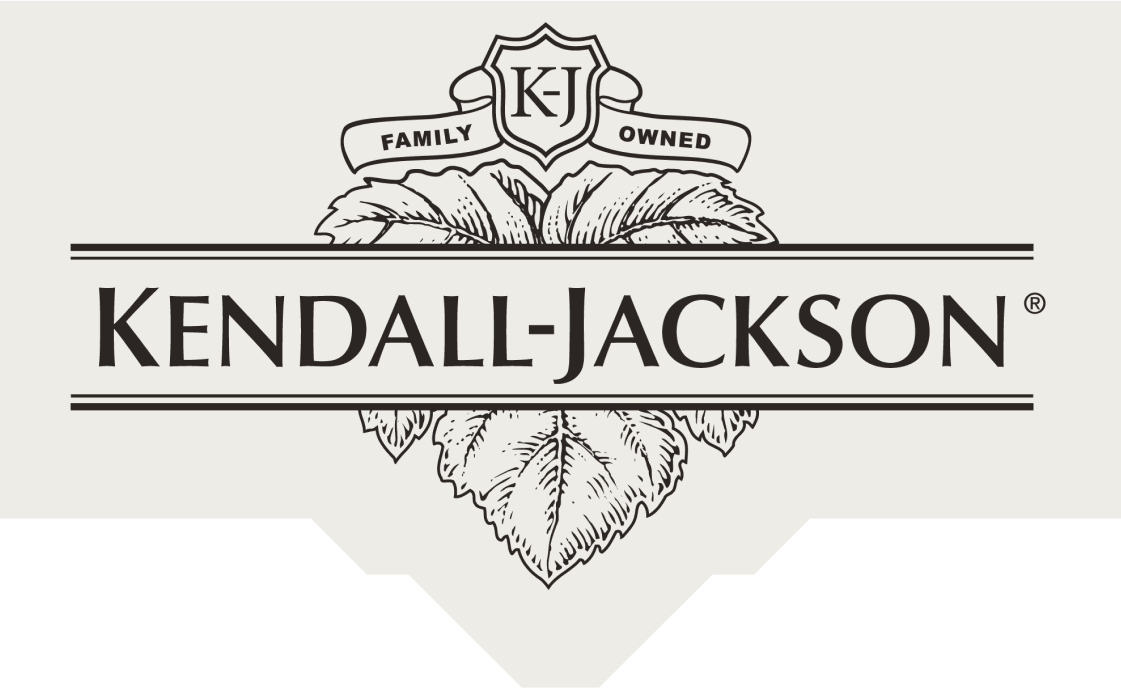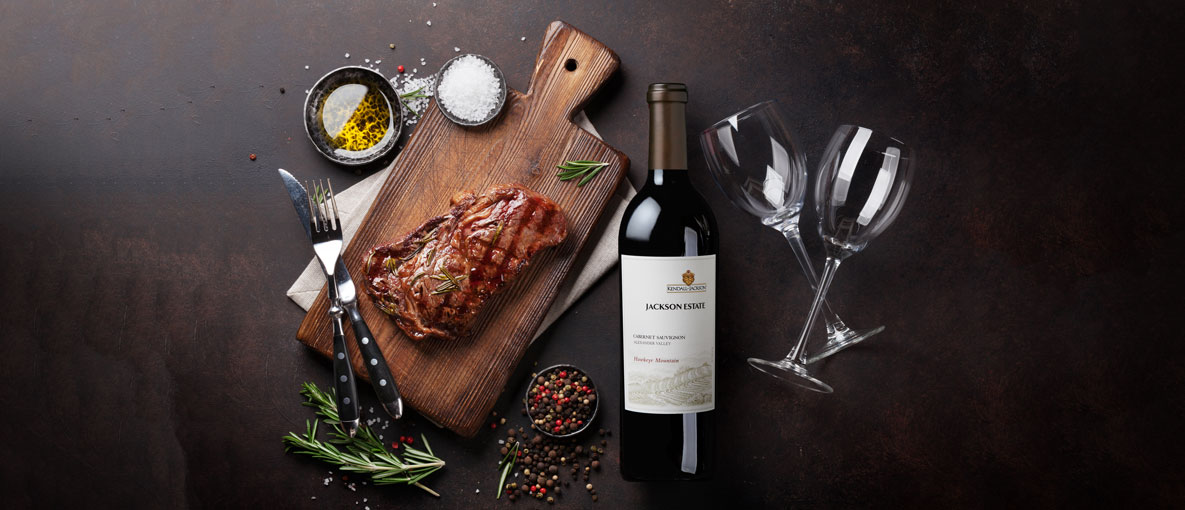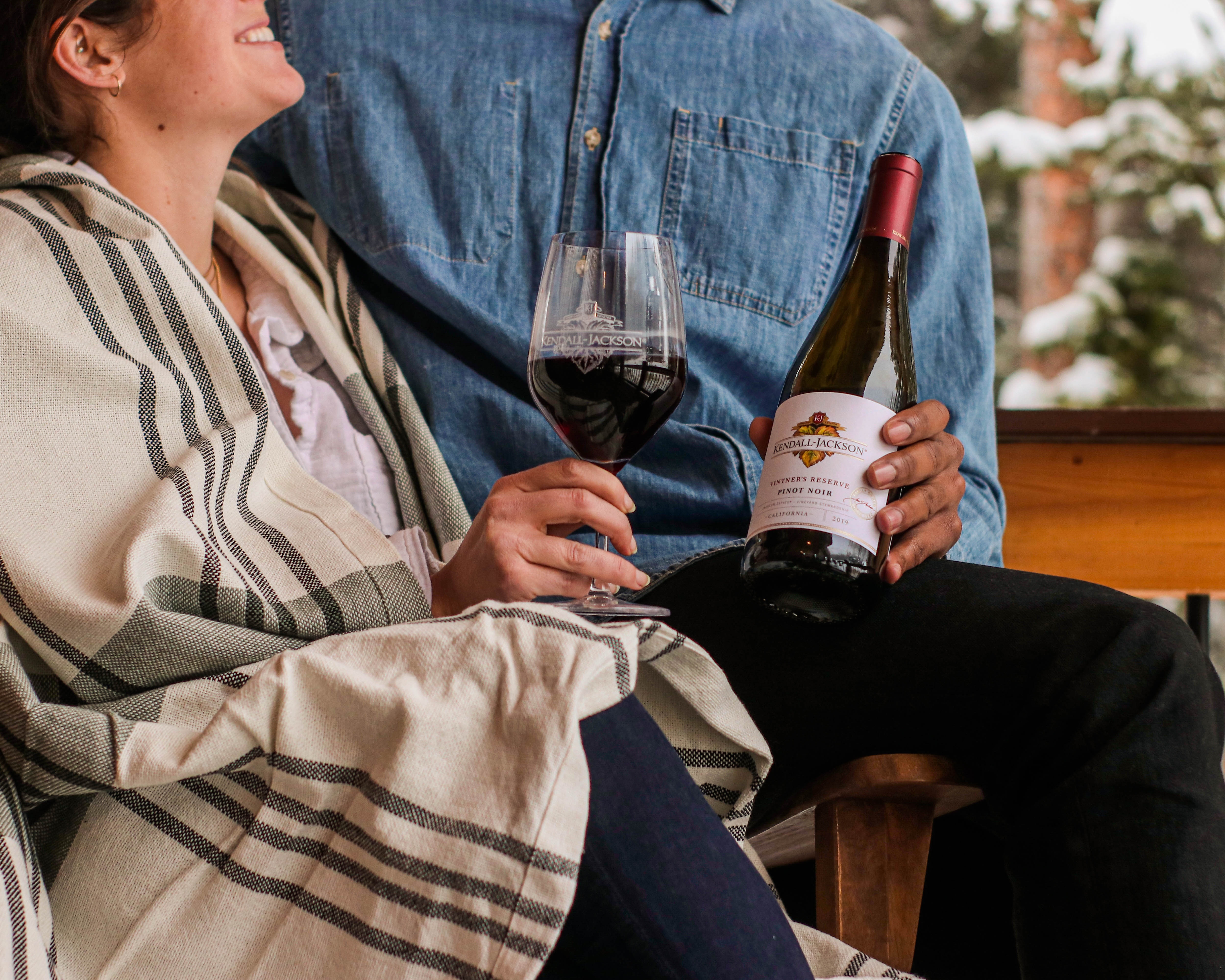Cabernet Sauvignon 101: Everything You Need to Know
Welcome to the ultimate Kendall-Jackson guide on Cabernet Sauvignon (pronounced ka-ber-nay-sow-veen-yawn), often referred to as “Cab” or “Cab Sauv.” Whether you're a seasoned wine enthusiast, a beginner looking to broaden your palate, or a foodie eager to find the perfect wine pairing, this guide is for you. We’ll dive into the rich history of Cabernet Sauvignon, explore its global popularity, and discuss its unique characteristics. You’ll learn about techniques that winemakers use to craft Cabernet Sauvignon as well as how it compares to other red wine varieties like Merlot and Pinot Noir. Find useful advice on serving, pairing, and selecting the best bottles, too.
A Brief History of Cabernet Sauvignon
Cabernet Sauvignon's story begins in the 18th century in France’s Bordeaux region. This remarkable grape arose through a serendipitous crossing of Cabernet Franc and Sauvignon Blanc in the vineyards. Over the centuries, it has grown to become the most widely planted red grape and one of the most celebrated wine varieties around the world.
The Global Popularity of Cabernet Sauvignon
Today, Cabernet Sauvignon is beloved worldwide. From Bordeaux to Napa Valley, and from Argentina to Australia, this grape has found a home in numerous wine regions. Its adaptability to different climates and soils makes it a winemaker's favorite. But what truly sets it apart is its rare combination of approachability and ageability, making it a favorite among casual sippers and connoisseurs alike.
Key Facts About Cabernet Sauvignon
- Origin: Bordeaux, France
- Top Growing Regions: France, California, Washington, Argentina, Chile, South Africa, Italy
- Taste: Rich, full-bodied with dark fruit flavors, often accompanied by notes of mint, tobacco, and leather
- Sweetness: Dry
- Color: Deep ruby red to purple
- Average Alcohol by Volume (ABV): 13.5% to 15%
- Ageability: Excellent, often improving with 5-10 years in the bottle

6 Commonly Asked Questions About Cabernet Sauvignon Wine
1. What is Cabernet Sauvignon Wine?
Cabernet Sauvignon is a full-bodied red wine known for its high tannin content, rich flavors, and excellent aging potential. It often exhibits flavors of blackcurrant, plum, and a hint of bell pepper or mint, complemented by notes of vanilla and cedar from aging in oak barrels.
2. Why Drink Cabernet Sauvignon Wine?
Cabernet Sauvignon’s bold flavors and firm tannins can support and enhance a variety of foods, from hearty meats to mild cheeses. Plus, its aging potential allows wine enthusiasts to enjoy its evolving flavors over time. If you're looking for a wine that combines depth, versatility, power, and a touch of elegance, Cabernet Sauvignon is an excellent choice. Whether you’re enjoying a young, vibrant Cab or an aged, sophisticated one, Cabernet Sauvignon offers a sensory adventure that's hard to match.
3. What Does Cabernet Sauvignon Taste Like?
When you uncork a Cabernet Sauvignon, expect a symphony of dark fruits—such as blackberries, blackcurrants, and black cherry, often layered with notes of mint, eucalyptus, and sometimes hints of vanilla, baking spices, tobacco, cedar, chocolate, or coffee from oak aging. These complex flavors contribute to Cabernet Sauvignon’s reputation as a rich and robust wine.
4. Is Cabernet Sauvignon Dry or Sweet?
Cabernet Sauvignon is predominantly a dry wine, meaning it has little to no residual sugar–typically measured as 17g/L of residual sugar or less. Our winemakers prefer to make our wines with virtually no residual sugar (less than 10 g/L) so you can always expect Kendall-Jackson Cabernet Sauvignons to be dry, never sweet. This dryness, combined with high tannin levels, gives the wines a bold structure that pairs well with rich foods.
5. What are the Tannin Levels in Cabernet Sauvignon?
Cabernet Sauvignon is known for its high tannin content. Tannins are compounds that add astringency to wine, while contributing to its structure and aging potential. These tannins can sometimes make young Cabernets feel quite astringent, but they soften and become more integrated as the wine ages. Cabernet Sauvignon grapes grown at a higher elevation–like those that Kendall-Jackson bottles–tend to receive more direct sunlight thus creating thicker skins and stronger tannins.
6. How Does Cabernet Sauvignon Age?
High-quality Cabernet Sauvignon can age beautifully for decades, gaining complex aromas, flavors, and textures over time. Experience this for yourself by tasting an older or library vintage, such as Stature Cabernet Sauvignon from Kendall-Jackson. Stature Cabernet Sauvignon is sourced from the best barrels from premium vineyards and is prized for its depth and nuanced flavors that have developed over decades. For more information on aging wines, check out our detailed guide here.
Understanding the Cabernet Sauvignon Winemaking Process
Cultivation and Growing Conditions
The journey of Cabernet Sauvignon from vine to bottle involves meticulous care and precision. These grapes thrive in well-drained soils and benefit from warm, sunny days and cool nights. The warmth helps the grapes to ripen, while the cool temperatures extend the number of days the grapes hang on the vine, enabling them to develop intense, complex flavors. Vineyard management practices, such as pruning and canopy management, are crucial to ensure there are an optimal number of clusters on the vine and that they receive the perfect amount of sunlight to ripen to perfection.
Harvesting Techniques
Harvesting Cabernet Sauvignon grapes is a delicate process that involves timing the pick to achieve the perfect balance of sugar, tannins, and acidity. Hand-picking is often preferred to minimize damage to the grapes and is essential in high-elevation, mountain vineyards that are too steep for tractors and heavy machinery.
Winemaking Techniques
The winemaking process for Cabernet Sauvignon involves several key steps. Winemakers often use techniques like cold soaking to extract color and flavor before fermentation. During fermentation, the winemaker will ensure the grape skins remain in contact with the juice to enhance the wine's color and tannin structure. Because the carbon dioxide produced during fermentation causes the grape skins to rise to the top of the barrel or tank and form a cap, a winemaker can punch down the cap with a plunger-like tool to let the juice flow over the skins. Alternatively, the winemaker might use pump overs for extraction, which requires pumping the juice from the bottom of the tank over the top of the cap.
Once the juice has fermented into wine, it is pressed off the skins. This is followed by aging in oak barrels, which imparts additional aromas, flavors, and textures. Kendall-Jackson works with World Cooperage to customize a barrel’s toast, and even which forest it derives from, to align with our winemaker Randy Ullom’s preferences for each wine. When it comes to barrels, Randy loves France’s Vosges forest!
Blending with other grape varieties, such as Merlot, Cabernet Franc, Petit Verdot, and Malbec, is also common, especially in regions like Bordeaux. Merlot’s softness, for example, can counterbalance Cabernet Sauvignon’s robust tannins.
Popular Cabernet Sauvignon Regions and Styles
Cabernet Sauvignon flourishes in a variety of climates, but it prefers warm regions with ample sunlight and well-drained soils. Bordeaux, France as well as Napa Valley and Sonoma County, California are some of the top regions producing stellar Cabernets.
Bordeaux, France
Bordeaux is the birthplace of Cabernet Sauvignon and remains a benchmark for quality. Bordeaux blends often combine Cabernet Sauvignon with Merlot, Cabernet Franc, and smaller amounts of Petit Verdot and Malbec, resulting in ageworthy wines that have balance, structure, complexity, and elegance.
Napa Valley, California
Napa Valley is renowned for its bold, opulent Cabernets. The region's warm climate and diverse soils produce wines with intense, dark fruit flavors, robust tannins, and great aging potential.
Sonoma County, California
Sonoma County offers a slightly different take on Cabernet Sauvignon, with a focus on balance and finesse. The cooler, ocean-driven climate of some Sonoma County sub-regions imparts lighter, red fruit notes to the wines.
Paso Robles, California
Paso Robles is an emerging star for Cabernet Sauvignon, known for its rich, approachable, fruit-forward styles. The region's diverse microclimates and soils contribute to a wide range of expressions.
Other Notable Regions
In addition to France and California, regions like Argentina, Australia, and South Africa are gaining recognition for their high-quality Cabernet Sauvignons. Each region brings its unique terroir and winemaking techniques to the table, resulting in diverse styles. You might find Cabernet blended with Shiraz in Australia, with Sangiovese in Italy, or with Malbec in Argentina.
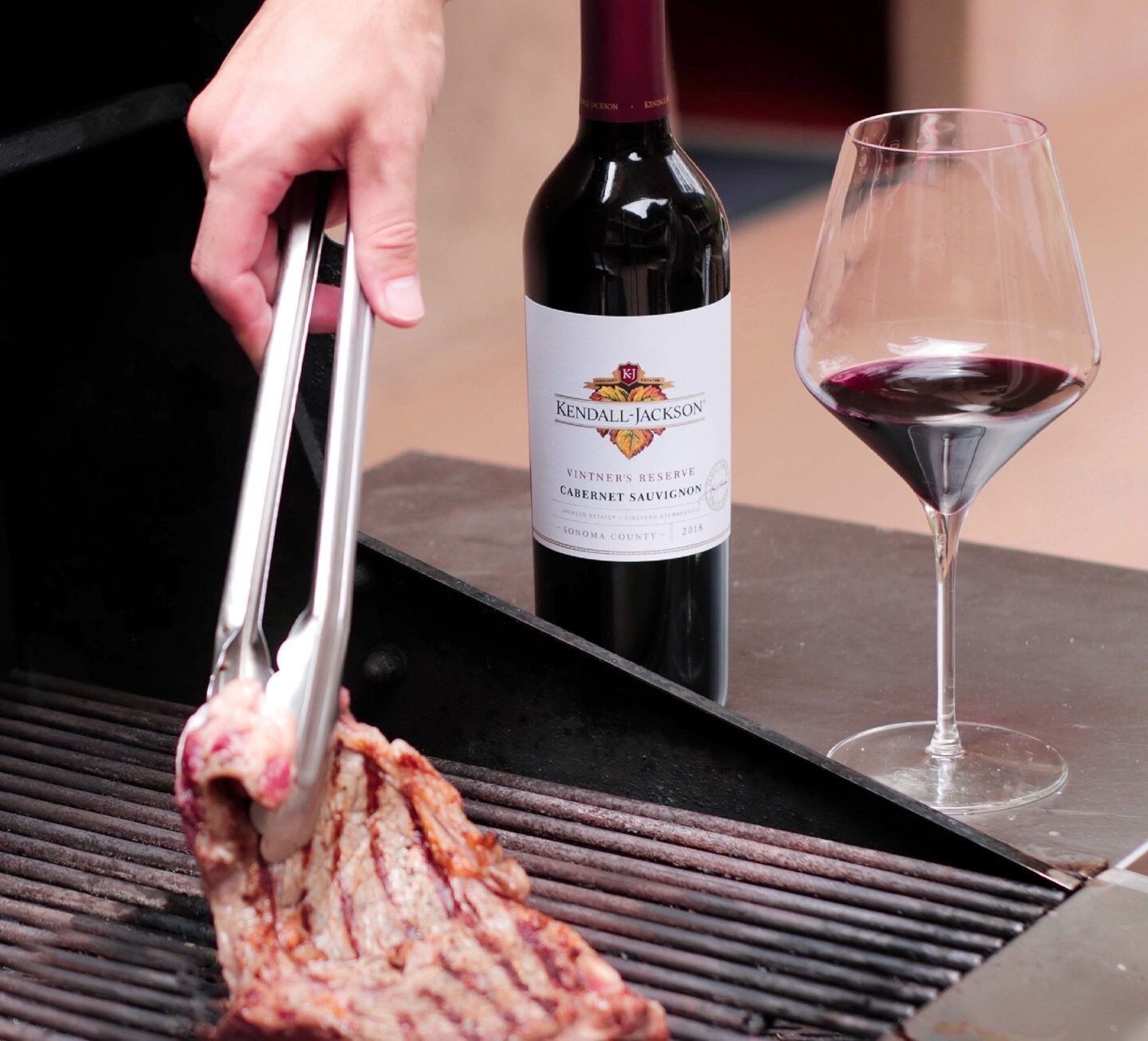
Recommended Cabernet Sauvignon Food Pairings
Best Dishes to Pair with Cabernet Sauvignon
Cabernet Sauvignon’s bold flavors and high tannins complement rich, hearty foods. Here are some top pairing suggestions:
- Steak, Grilled Meats, and Denser Fishes: The tannins in Cabernet Sauvignon cut through the richness of fatty meats, making it an ideal companion for steak (“Cab and a Slab” as the saying goes) and other grilled meats or dense fishes, such as ribeye, halibut, or swordfish.
- Hearty Stews: Slow-cooked dishes like beef stew or lamb shanks match well with the robust flavors of Cabernet Sauvignon.
- Aged Cheeses: The bold flavors of Cab pair beautifully with aged cheeses like cheddar and gouda.
Recipes to Try
The dark fruit and herbaceous notes of Cabernet Sauvignon complement a wide range of flavors, including peppery stews, umami mushroom and tomato dishes, and even coffee and chocolate desserts. For some delicious pairing ideas, check out these recipes:
- Crock Pot Beef Stew
- Roasted Garlic & Caramelized Onion Grilled Cheese with Creamy Tomato Soup
- Chocolate Almond Bark with Cabernet Sauvignon
Complete Pairing Guide
Cabernet Sauvignon's robust profile can bring out the flavors of various foods. Its tannins and acidity cleanse the palate, making each bite more enjoyable. For more suggestions, check out our wine pairing guide on our entertaining page.
How to Serve Cabernet Sauvignon
Serving Temperature and Glassware
To fully enjoy Cabernet Sauvignon, serve it at room temperature between 60-65°F. Use a large, wide-bowled glass to allow the wine to breathe and release its aromas. For more on glassware, check out our wine glass guide.
Decanting and Aerating
Decanting Cabernet Sauvignon can enhance its flavors by allowing it to breathe, soften the tannins, and reveal its bouquet. Pour the wine into a decanter and let it sit for about 30 minutes before serving. Aerators can also be used as a quicker option.
Cellaring and Aging Potential
Cabernet Sauvignon has excellent aging potential. Store it in a cool, dark place with low humidity, few vibrations, and a consistent temperature between 50-55°F. For more tips on storing wine, visit our storage guide.
Cabernet Sauvignon vs Merlot
Key Differences in Taste and Pairings
Cabernet Sauvignon and Merlot are both popular red wines, but they have distinct differences. Cabernet Sauvignon is known for its bold, tannic structure and dark fruit flavors, while Merlot is softer and more approachable, with flavors of plum and chocolate. Cabernet pairs well with hearty meats, while Merlot complements lighter dishes like roasted chicken.
Differences in Tannins and Regions
Cabernet Sauvignon generally has higher tannin levels compared to Merlot, contributing to its robust structure. In addition, Cabernet’s tannins tend to be felt around the gumline in a donut shape and not directly on the tongue. This is one reason why winemakers like to blend it with Merlot, as Merlot’s velvety tannins are felt on the tongue, filling the hole of the donut so to speak. While both grapes are grown in Bordeaux, Cabernet thrives in warmer climates like Napa Valley, whereas Merlot prefers cooler regions such as Bordeaux’s Right Bank.
Color and Aging Potential
Cabernet Sauvignon typically has a deeper, darker color than Merlot. Both wines have good aging potential, but Cabernet's higher tannin content often allows it to age longer and generally develop more complex flavors over time.
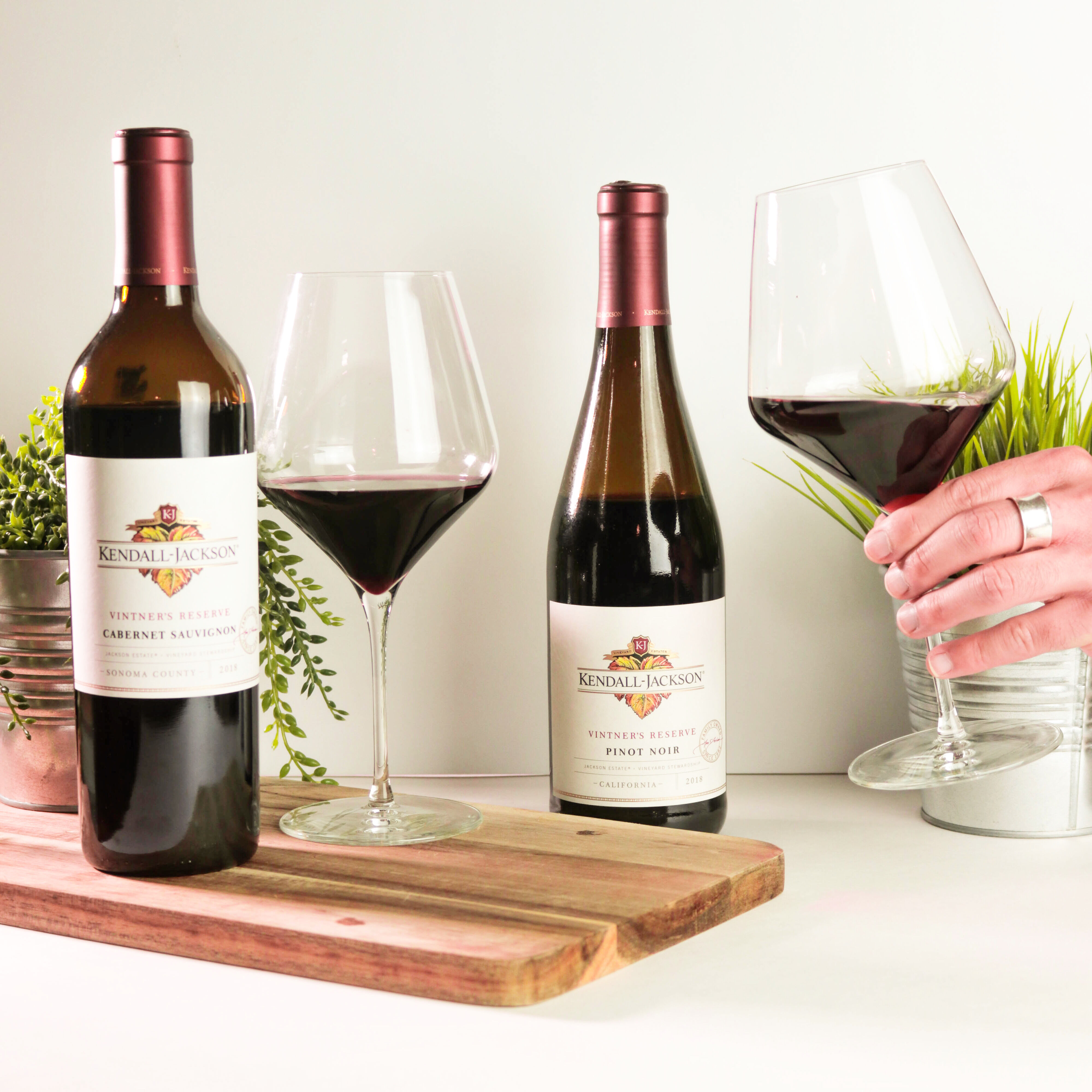
Cabernet Sauvignon vs Pinot Noir
Key Differences in Taste and Pairings
Cabernet Sauvignon and Pinot Noir are quite different. Cabernet is full-bodied with dark fruit flavors and high tannins, making it ideal for rich, savory dishes. Pinot Noir, on the other hand, is lighter bodied with red fruit flavors like cherry and raspberry. It's a versatile wine that pairs well with a wide range of foods, from salmon to duck. Both varieties pair well with mushrooms!
Differences in Tannins and Regions
Pinot Noir has much lower tannin levels compared to Cabernet Sauvignon, resulting in a smoother, more delicate mouthfeel. While Cabernet is prominent in regions like Napa Valley and Bordeaux, Pinot Noir is famously associated with Burgundy, France, and the cooler climates of Oregon and New Zealand.
Color and Aging Potential
Pinot Noir typically has a lighter color than Cabernet Sauvignon. Although both wines can age, Pinot Noir's delicate nature often means it peaks sooner than the more robust Cabernet.
How to Choose the Perfect Cabernet Sauvignon
Choosing the perfect Cabernet Sauvignon can be a wonderful way to explore the world from your glass. Here are some tips to guide you:
- Region: Consider the region where the wine is produced. Each region has its unique characteristics, and knowing your preference can help narrow down your choices.
- Vintage: Look for reputable vintages. Some years produce better grapes due to favorable weather conditions.
- Winery: Explore wines from renowned wineries known for their quality and consistency.
- Personal Taste: Identify your flavor preferences. Do you prefer a bold, tannic wine or something soft and smooth?
- Price: Set a budget. While some high-end Cabernet Sauvignons are exceptional, there are many affordable options that also offer great value.
Top 5 Best Cabernet Sauvignon Wines Recommended by Kendall-Jackson
Here are our top five picks for the best Cabernet Sauvignon wines. Whether you’re new to or well-versed in wine, you’ll find a wine in this list to enjoy while cooking, hosting, celebrating, or building out your cellar.
Vintner’s Reserve Cabernet Sauvignon
This wine offers a harmonious blend of black currant, mocha, and vanilla flavors with an elegant, velvety finish. It's a perfect introduction to the world of Cabernet Sauvignon.
Grand Reserve Cabernet Sauvignon
Rich and full-bodied, this wine has sumptuous flavors of blackberry, blueberry, red and black currants with a hint of chocolate and vanilla. An ideal bottle for elegant dinners.
Jackson Estate Poet's Peak Cabernet Sauvignon
A complex wine with layers of dark fruit and spice, its ripe, powerful mountain tannins create irresistible richness. Enjoy with a roasted lamb dish for an exquisite experience.
Jackson Estate Hawkeye Mountain Cabernet Sauvignon
This mountain-grown Cabernet offers intense flavors of black cherry and cassis with elegant minerality. The kind of wine you savor for hours in front of a fireplace in winter.
A pinnacle of provenance and craftsmanship, this wine features opulent flavors of dark plum, violet, and tobacco with velvety tannins. A mesmerizing wine to celebrate a milestone, accomplishment, engagement, or anniversary.
Final Thoughts
Cabernet Sauvignon's versatility, bold flavors, and rich profile make it a favorite among wine lovers. Its ability to pair with various foods and its aging potential add to its allure. Whether you're new to wine or a seasoned enthusiast, there's always something new to discover with Cabernet Sauvignon.

Discover Kendall-Jackson's Award-Winning Cabernet Sauvignon Portfolio
At Kendall-Jackson, we are dedicated to producing the best Cabernet Sauvignon, using sustainable practices and innovative techniques. We offer an impressive collection of Cabernet Sauvignon wines, each crafted with precision and care. Our portfolio includes:
- Vintner’s Reserve: Artful blends known for their approachable and vibrant flavors, derived from four coastal counties.
- Grand Reserve: A step up in complexity and refinement, sourced from a single county.
- Jackson Estate: Single vineyard wines from a single appellation, highlighting the unique terroirs
- Stature: Our pinnacle of winemaking excellence showcasing the best barrels of the best single vineyards.
Frequently Asked Questions
What kind of wine is a Cabernet Sauvignon?
Cabernet Sauvignon is a full-bodied red wine known for its high tannins, deep color, and complex flavors of dark fruit, such as blackberry and blackcurrant.
Is Cabernet Sauvignon a beginner wine?
While Cabernet Sauvignon can be approachable when young and enjoyed by beginners, its bold flavors, high tannins, and ageability will also appeal to those with some wine experience or collectors.
What are the characteristics of a good Cabernet Sauvignon?
A good Cabernet Sauvignon will have a balanced structure, with rich dark fruit flavors, well-integrated tannins, and a smooth finish.
Is Cabernet Sauvignon sweet or dry?
Cabernet Sauvignon is typically dry, with minimal residual sugar. Our winemakers prefer to make our wines with virtually no residual sugar so you can always expect Kendall-Jackson Cabernet Sauvignons to be dry, never sweet.
Should Cabernet Sauvignon be chilled?
Cabernet Sauvignon should be served at a slightly cool room temperature, around 60-65°F (15-18°C), rather than chilled.
